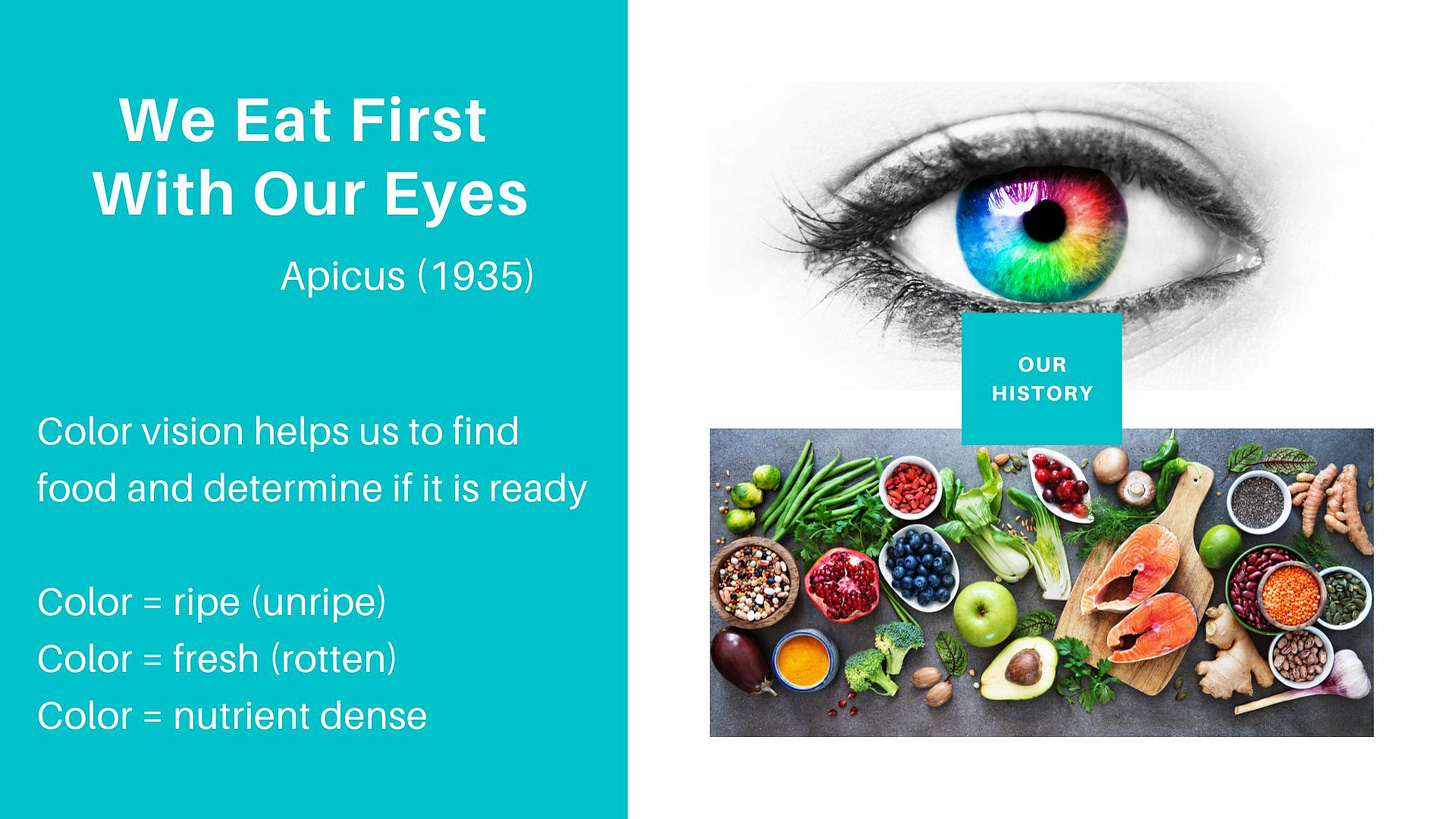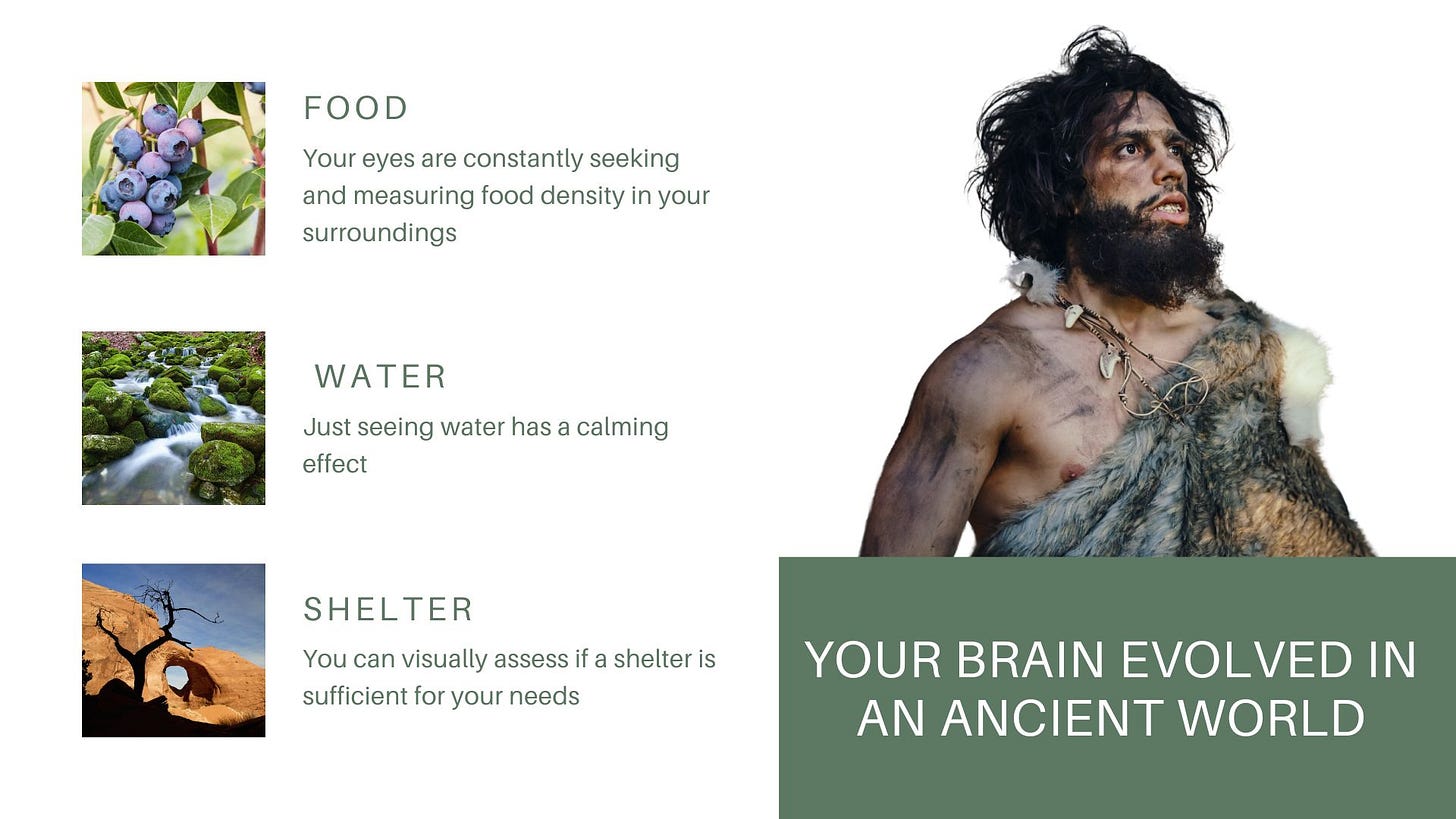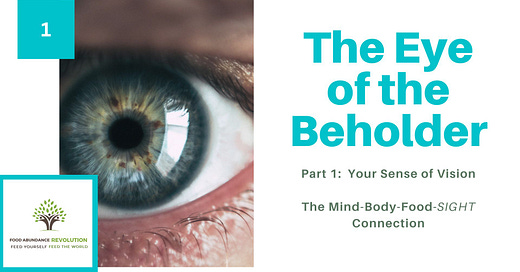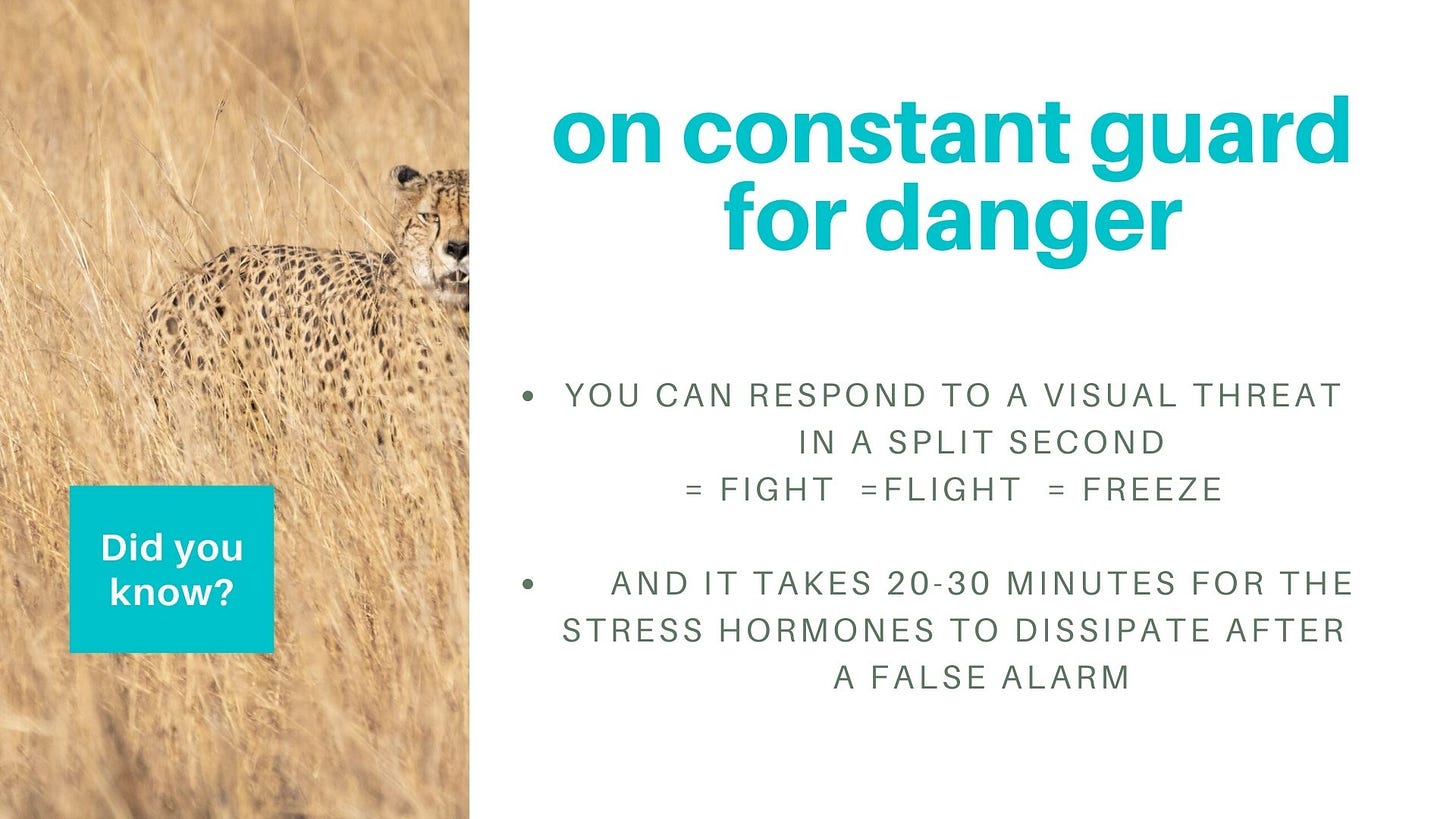The Eye of the Beholder - Part 1
Your Mind-Body-Sight-Food Connection
Your Senses
Starting this week, I will be rolling out the first of a five-part series on Your Senses in The Mind-Body-Food Connection. In each part, I have been researching and examining how each of our senses affects our Mind-Body Connection in relation to Food:
· Section I: The Eye of the Beholder (your sense of sight)
· Section II: Sentilicous Sensations (your sense of smell)
· Section III: Sound and Silence (your sense of hearing)
· Section IV: Our Tactile Tendencies (your sense of touch)
· Section V: Taste the Wonder (your sense of taste)
If you are interested in working through these concepts in a more personalized and guided manner, then join the waitlist for the next Mind-Body-Food Connection Program offered at Food Abundance Revolution. Otherwise, stay tuned here. To get all the components of this series, you will need to become a paid subscriber.
We are going to start our journey with sight because for the vast majority of humans, sight is their primary sense for gathering data and making sense of the world.
Seeing something that represents danger is the primary trigger for our stress response which is integral to our ongoing survival. However, sight is also how we find food, water and shelter, and interpret social cues. It makes sense that sight is deeply embedded in our Mind-Body-Food Connection. Let’s dive in!
Oh Your Eyes!
Our eyes are truly amazing works of nature. From the moment light enters our eyes, we are collecting and processing information. Your eye can transmit data to your brain at a speed of 10 million bits per second (2006).
Your eyes are involved in daily life and death decisions, although we rarely think about it like that.
When you see something frightening, signals in your brain trigger your sympathetic nervous system. This is the system that controls your stress reactions often referred to as “fight or flight.” When your eyes send an alert signal like “DANGER – There’s a predator in front of you”, it triggers your body to prepare for that danger instantly, automatically.
In fact, there are 4 possible stress responses not just two or three.
You might prepare to fight the predator.
You might freeze in the hopes that the predator will not see you moving and thus lose interest.
You might flee and try running to the nearest tree to climb.
And “fawn” is the fourth possible response which does not apply to a predator, but does apply in social situations where you might try to appease a bully or a captor so that they will not harm you.
While you can train yourself to modify these responses, your body is hardwired for survival first and foremost.
Your eyes play a critical role in your stress response even though most of us do not face off with predators on a daily basis anymore. Our eyes are constantly scanning for signs of danger and in the context of modern life, this can leave us on high alert most of the time.
But here’s the thing:
Your brain cannot tell the difference between a perceived threat and a real one.
Consider these examples:
· A car crash unfolding in front of you causes your heart to pound in your chest just as surely as if you, yourself, were inside the car being hit.
· You may sweat, shiver or have an upset stomach (all stress responses) from seeing your frowning boss, even if she changes direction and delivers a reprisal to someone else.
· You might also experience these same physical reactions later in the evening as you tell your friend about the car or your boss (re-telling the story).
· And you might experience them again later at night when you can’t sleep because you are thinking about what happened (imagined scenes).
In each case, your body is physically experiencing stress even though the direct danger to you is negligible. So it’s easy to see why our modern lives leave us stressed all the time.
We are bombarded by visual information coming at us with speeds like never before in the history of our human evolution.
Your brain is built to process visual information and it can processes images 60,000 times faster than text (2014). Images that you see, and the stress response they trigger, can play out over and over in your mind, leaving you vulnerable to stress-related illness.
What we see, and focus on, affects the state of our mind and body.
You can see a star billions of miles away,
but may not see the camouflaged insect (or predator) in front of you.
-Sue Senger
Your Eyes and Food
Now let’s connect the dots between your eyes and food.
Our eye sight, stress response, focus and attention all evolved to do one thing well: SURVIVE.
You are an ancient human living in a modern world and food is still essential for your survival, along with water and shelter.
In our ancient past, securing food, or planning how to secure food, took up most of our lives every single day. We had to find food and hunt or gather it. Or we had to take the time to grow food for ourselves instead of gathering it, or shepherd livestock in place of hunting wild animals.
Enough food = Survival.
For thousands of years we have relied on our eyes to help us find food in our surroundings. Our color vision helps us determine if that food is ready to harvest or safe to eat.
We eat first with our eyes.
Apicus (1935)
With our eyes, we can easily determine if fruit and other food is ripe and ready or unripe. We also use visual cues to assess if food is fresh or rotten. But did you know that you also automatically assess the nutrient density of your surroundings?

When I first heard about this concept of nutrient density assessments for humans I didn’t think it was really true. How could that actually work? Are we really doing that today? But as I considered it more carefully through my work as a biologist, it started to make sense to me.
Let me give you this example. Part of what I do as a biologist is assess wildlife habitat and make recommendations on whether changes are needed during development proposals to protect or enhance that habitat. With years of practice, I can walk into an area and say with certainty whether the area represents suitable grizzly bear habitat, for example. Is there enough food present in this area to attract and feed a foraging bear? THAT is the concept of nutrient density in a landscape and visually assessing that nutrient density. Within minutes of getting to an area, I am scanning and counting off the food plants and prey animals signs to determine if this is a good place for a grizzly bear to eat. It is automatic for me to do this in the context of my work.
Sounds easy for wildlife, but for humans?
The reality is that there are few people left on earth who recognize what natural, nutrient dense landscapes for humans even look like. Nor do many people understand the scale of food density necessary to support human communities. The closest sensation you may have is when you enter a grocery store and prepare to fill your cart. And sadly much of the food there isn’t designed to support your health! You may also catch a glimpse of this skill in action as you scan the restaurant signs in a new city block to find something you want to try.
Modern life has robbed us of the fundamental sense of connectedness to our food and yet our eyes and brains are still doing the same ancient math. Where is the food? What condition is it in? Is there enough? Do I need more? Our biological need to survive has not changed, even if our food system has been simplified.

What comes next?
In the coming installments of Eye of the Beholder – Part I, we are going to dive deeper into how your eyes are affecting your Mind-Body-Food Connection. I’ll be talking about:
The shift to modern eating habits and the void left in our sight-mind patterns for food.
How BIG-Food (aka. multi-national food corporations) manipulate your sight in the game to sell you more food . . .because once you see what they are doing, you can make better decisions!
Then we will shift to how Nature can reset your sense of sight, and help balance your response to food.
Lastly, I will leave you with some activities that will help you connect with your sight-food relationship and understand it better on a personal level.
I’m not yet sure if this is one, two or four posts. But regardless of how this rolls out, you can join me here at The Naturalized Human, as a paid subscriber to not miss this sensational sight journey!
Stay tuned!
If you have enjoyed this newsletter and want to share it with friends, just click the link below to share this post.
The Mind-Body-Food Connection is a 13 week program offered through my website Food Abundance Revolution. If you are interested in exploring this material in a guided and more personal/interactive fashion, join the waitlist for the next program opportunity.





